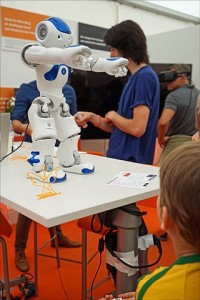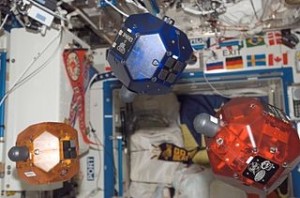A humanoid space robot
Nao robots are finding uses in many areas. These little guys have been the first to show signs of self-awareness and are one of the most popular robots for education and research. Now a Nao robot could be the first humanoid robot to take up permanent residence on the International Space Station (ISS).
Now, I know some of you might be saying wait a minute here. Isn’t there already a humanoid robot on the ISS? After all, Robonaut 2 has already made a home on the ISS and has proved to be a valuable member of the crew. I asked this question myself. I wonder if Robonaut is not considered humanoid since it does not have the lower part of its body attached. Or maybe Robonaut is not a permanent part of the crew. At any rate, in the article I read about this, Nao is being touted as the first permanent humanoid resident.

Futur en Seine digital technology festival, Paris, June 2015. Le robot Nao. Jean-Pierre Dalbéra from Paris, France
A research team at the French Institute of Health and Medical Research just put mankind a bit closer to complete robot rule this past month, outfitting the humanoid robot Nao with an “autobiographical memory.” To make this accomplishment even more astounding, the team intends to push for its new robotic system to become a permanent member of the International Space Station.
Not the first robots on the ISS
Nao may be considered the first humanoid robot on the ISS, but it will not be the first robot. There have been many robots on the station over the years. The station has several robot arms to assist with tasks such as capturing resupply vehicles and moving station modules into place. Perhaps the most famous is the Canadarm2 or the Mobile Servicing System (MSS). This robotic arm was launched to the ISS in 2001. It has been very important in assembly of the ISS. Also, its aids astronauts when they are conducting spacewalks.
Another robot on the station is the Robonaut 2. This humanoid robot, also known as R2, went to the ISS on the shuttle Discovery in the STS-133 mission. R2 is a test platform to generate data on how a robot may work with astronauts in the future. This bot has the ability to work autonomously as well as to be tele-operated by the astronauts or from the ground.

Three satellites fly in formation as part of the Synchronized Position Hold, Engage, Reorient, Experimental Satellites (SPHERES) investigation. This image was taken during Expedition 14 in the Destiny laboratory module. NASA/International Space Station Expedition 14 Public domain.
If you count the robotic arms on the ISS, there are quite a few robots onboard the station already. Besides the previously mentioned Robonaut, there are the SPHERES.
NASA has been testing SPHERES on the space station since 2011.
Pictured in the photo to the center left, they are flying in formation. These free-flyers will receive an upgrade with a smartphone to become a bot known as Smart SPHERES.
…this prototype free-flying space robot equipped with a smartphone, known as Smart SPHERES (Synchronized Position Hold, Engage, Reorient Experimental Satellites).
The station astronauts have upgraded these existing space robots to use Google’s “Project Tango” smartphone, which features a custom 3-D sensor and multiple cameras. Smart SPHERES are being used to test free-flying 3-D mapping and navigation inside the space station. NASA developed the Smart SPHERES to perform work on the space station that requires the mobile sensing the bots have onboard. It is hoped they will carry out environmental monitoring of levels of radiation, lighting, and air quality. Smart SPHERES is funded by the Space Technology Mission Directorate at NASA Headquarters.
What is the future for robots on the ISS and beyond?
Robots will continue to play a role on the ISS as new and more capable machines are developed. When missions beyond low Earth orbit are conducted in the future robots will almost certainly be along side of the astronauts. Its hard to imagine that they would not. Space robotics will be able to enhance the ability of humans to conduct safe and successful missions.
What is your opinion on the place of robots in human spaceflight? Let me know with your comments.
Source: NASA Ames Launches Smartphone Upgrade and CubeSat Aboard Orbital Rocket
Source: A humanoid robot may soon be the first permanent resident on the ISS



Recent Comments